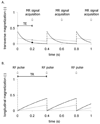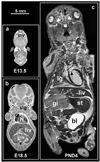Small animal imaging with magnetic resonance microscopy
- PMID: 18172332
- PMCID: PMC2770253
- DOI: 10.1093/ilar.49.1.35
Small animal imaging with magnetic resonance microscopy
Abstract
Small animal magnetic resonance microscopy (MRM) has evolved significantly from testing the boundaries of imaging physics to its expanding use today as a tool in noninvasive biomedical investigations. MRM now increasingly provides functional information about living animals, with images of the beating heart, breathing lung, and functioning brain. Unlike clinical MRI, where the focus is on diagnosis, MRM is used to reveal fundamental biology or to noninvasively measure subtle changes in the structure or function of organs during disease progression or in response to experimental therapies. High-resolution anatomical imaging reveals increasingly exquisite detail in healthy animals and subtle architectural aberrations that occur in genetically altered models. Resolution of 100 mum in all dimensions is now routinely attained in living animals, and (10 mum)(3) is feasible in fixed specimens. Such images almost rival conventional histology while allowing the object to be viewed interactively in any plane. In this review we describe the state of the art in MRM for scientists who may be unfamiliar with this modality but who want to apply its capabilities to their research. We include a brief review of MR concepts and methods of animal handling and support, before covering a range of MRM applications-including the heart, lung, and brain-and the emerging field of MR histology. The ability of MRM to provide a detailed functional and anatomical picture in rats and mice, and to track this picture over time, makes it a promising platform with broad applications in biomedical research.
Figures
















Similar articles
-
Morphology of the small-animal lung using magnetic resonance microscopy.Proc Am Thorac Soc. 2005;2(6):481-3, 501-2. doi: 10.1513/pats.200507-074DS. Proc Am Thorac Soc. 2005. PMID: 16352752 Free PMC article. Review.
-
Imaging techniques for small animal models of pulmonary disease: MR microscopy.Toxicol Pathol. 2007 Jan;35(1):49-58. doi: 10.1080/01926230601132048. Toxicol Pathol. 2007. PMID: 17325972 Free PMC article.
-
Magnetic resonance microscopy.Stud Health Technol Inform. 2013;185:153-84. Stud Health Technol Inform. 2013. PMID: 23542935 Review.
-
Histology by magnetic resonance microscopy.Magn Reson Q. 1993 Mar;9(1):1-30. Magn Reson Q. 1993. PMID: 8512830 Review.
-
Magnetic resonance microscopy approaches to molecular imaging: sensitivity vs. specificity.J Cell Biochem Suppl. 2002;39:147-53. doi: 10.1002/jcb.10421. J Cell Biochem Suppl. 2002. PMID: 12552614 Review.
Cited by
-
MARS: a mouse atlas registration system based on a planar x-ray projector and an optical camera.Phys Med Biol. 2012 Oct 7;57(19):6063-77. doi: 10.1088/0031-9155/57/19/6063. Epub 2012 Sep 12. Phys Med Biol. 2012. PMID: 22968224 Free PMC article.
-
A digital multigate Doppler method for high frequency ultrasound.Sensors (Basel). 2014 Jul 24;14(8):13348-60. doi: 10.3390/s140813348. Sensors (Basel). 2014. PMID: 25061836 Free PMC article.
-
Noninvasive assessment of cardiac abnormalities in experimental autoimmune myocarditis by magnetic resonance microscopy imaging in the mouse.J Vis Exp. 2014 Jun 20;(88):e51654. doi: 10.3791/51654. J Vis Exp. 2014. PMID: 24998332 Free PMC article.
-
3D MR Fingerprinting for Dynamic Contrast-Enhanced Imaging of Whole Mouse Brain.ArXiv [Preprint]. 2024 Aug 5:arXiv:2405.00513v2. ArXiv. 2024. Update in: Magn Reson Med. 2025 Jan;93(1):67-79. doi: 10.1002/mrm.30253. PMID: 38745701 Free PMC article. Updated. Preprint.
-
In vivo imaging techniques: a new era for histochemical analysis.Eur J Histochem. 2016 Nov 28;60(4):2725. doi: 10.4081/ejh.2016.2725. Eur J Histochem. 2016. PMID: 28076937 Free PMC article. Review.
References
-
- Ahrens ET, Dubowitz DJ. Peripheral somatosensory fMRI in mouse at 11.7 T. NMR Biomed. 2001;14:318–324. - PubMed
-
- Ali AA, Dale AM, Badea A, Johnson GA. Automated segmentation of neuroanatomical structures in multispectral MR microscopy of the mouse brain. Neuroimage. 2005;27:425–435. - PubMed
-
- Altes TA, Powers PL, Knight-Scott J, Rakes G, Platts-Mills TAE, DeLange EE, Alford BA, Mugler JP, Brookeman JR. Hyperpolarized 3He MR Lung Ventilation Imaging in Asthmatics: Preliminary Findings. J. Mag. Res. Imag. 2001;13:378–384. - PubMed
Publication types
MeSH terms
Grants and funding
LinkOut - more resources
Full Text Sources
Other Literature Sources
Medical

